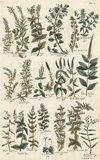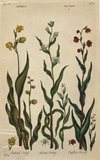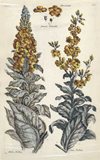In 1756 John Hill wrote The British Herbal: an History of Plants and Trees, Natives of Britain, cultivated for use or raised for Beauty. Each tall page illustrated five rows of up to six small hand-coloured copperplate engravings of botanical specimens. They are lovely herbal engravings - many can be seen at Antique Prints / Botany / Antique Herbal Engravings.
John Hill (1716-1775) began his working life with his father in his herb gardens, and attended lectures on Botany with the Worshipful Society of Apothecaries at Chelsea Physic Garden. After qualifying as an apothecary, Hill set up and practised medicine as a ‘quack’ (unqualified doctor) – but not for long. He was an energetic fellow with an enquiring mind. He seemed to have difficulty settling into one line of work, and soon took a break from tending the sick. He travelled the country gathering rare plants which he illustrated, described, collected seed from, and sold by subscription. In 1746 he attracted attention and gained approval from the Fellows of the Royal Society when he constructively added to a treatise on stones (rocks and gems) by Greek philosopher, Theophrastus (c.371 – c.287) who studied with Plato and Aristotle.
 John Hill found he enjoyed writing, and his literary output was enormous. His main contribution to knowledge was in the field of botany, but he also wrote on apothecary, medicine, geology and conchology, Thoughts concerning God and Nature, of married life, the art of acting, The Naval History of Britain, an opera, two comedies, novels, and a financially rewarding popular daily paper, “The Inspector”. This latter was to gain him widespread notoriety from his provocative comments on the shortcomings of others – in particular of the Royal Society and its 300 Fellows.
John Hill found he enjoyed writing, and his literary output was enormous. His main contribution to knowledge was in the field of botany, but he also wrote on apothecary, medicine, geology and conchology, Thoughts concerning God and Nature, of married life, the art of acting, The Naval History of Britain, an opera, two comedies, novels, and a financially rewarding popular daily paper, “The Inspector”. This latter was to gain him widespread notoriety from his provocative comments on the shortcomings of others – in particular of the Royal Society and its 300 Fellows.
Hill’s flamboyant social behaviour, and his satirical criticism of others and their organizations, inevitably caused irritation and opposition, and resulted in his not being given official recognition of his abilities; in particular, not being made a Fellow of the Royal Society despite his being more eligible than most of those appointed. His first official recognition was in 1774, a year before he died, when he was endowed with the Order of Vasa by King Gustavus III of Sweden, in recognition of his contribution in the field of agriculture. This knighthood was subsequently recognized by King George III. Isaac Disraeli wrote, “Yet Sir John Hill, this despised man, after all the fertile absurdities of his literary life, performed more for the improvement of the Philosophical Transactions, and was the cause of diffusing a more general taste for the science of botany, than any other contemporary.”
 Understanding that John Stuart, Earl of Bute, was appointing himself to supervise the expanding gardens at Kew, John Hill moved his family to accommodation in St James in 1757 or 1758. Unfortunately Bute chose fellow Scot William Aiton instead, but Hill continued to assist Bute, and procured over a thousand new botanical species for Kew Gardens. With family to support, Hill published numerous well-illustrated herbals, and sold herbs in a stall at Kensington Gardens.
Understanding that John Stuart, Earl of Bute, was appointing himself to supervise the expanding gardens at Kew, John Hill moved his family to accommodation in St James in 1757 or 1758. Unfortunately Bute chose fellow Scot William Aiton instead, but Hill continued to assist Bute, and procured over a thousand new botanical species for Kew Gardens. With family to support, Hill published numerous well-illustrated herbals, and sold herbs in a stall at Kensington Gardens.
Hill’s finances were already stretched when Bute proposed Hill produce an ambitious and grand work, The Vegetable System. From 1759 to 1775 Hill produced over 1500 folio-size hand-coloured botanical engravings (once again on hand-made paper), in anticipation of financial support from Bute. This was also the reason Hill acceded to Bute’s demand that he extend this enormous work to twenty-six volumes. Unfortunately the work resulted in both Hill’s death, and bankruptcy. It was a sad end to an intelligent, industrious and ambitious individual, who, more than any other, stimulated public interest in herbs and herbals.
Choose from wonderful early antique prints of herbs from our website - or make arrangements to visit the Antique Print Clubhouse at Neranwood in the Gold Coast Hinterland.